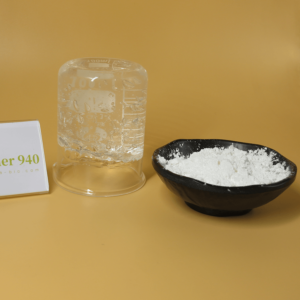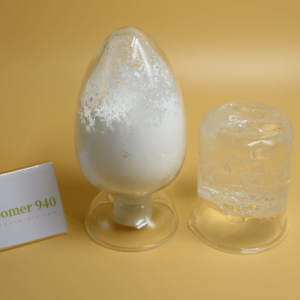1.Carbomer Dispersion Technology
Before thickening, the carbomer powder must be fully dispersed in the liquid medium. The carbomer powder is very easy to absorb moisture and agglomerate, and the surface is extremely easy to form a gel that protective layer to prevent rapid wetting inside the block. The following methods can be used to disperse:
1.) Carbomer powder was evenly sprinkled on the vortex surface of the solution to make it naturally swell.
2.) Add the prescription amount of glycerin, propylene glycol, or polyhexanediol to the drying container, sprinkle with carbomer to wet and swell, then add water to dissolve.
3.) Dispersion can be accelerated with 0.05% Anionic or Nonionic wetting agents, such as polysorbate 80.
4. ) Dry mixed with other dry ingredients first.
5. ) Appropriate stirring can accelerate the mixing of carbomer and solvent.
2.Carbomer Thickening Technology
Method 1: thickening with neutralizer
① The usual thickening method in water is to neutralize it with a monovalent inorganic base such as NaOH, KOH, NaHCO, or triethanolamine. The inorganic base should be added as a 10%-20% solution. Because the soluble divalent cations cause the carbomer powder to crosslink and cause the viscosity to decrease and sediment. It cannot be neutralized with a divalent base such as Ca(OH)2.
② In a weakly polar or non-polar organic solvent, neutralize with an amine soluble in the solvent medium used to ensure that the resulting salt is easily soluble in the solvent.
③ Excessive neutralization can cause viscosity loss. The amount of neutralizer can be estimated in advance, and the pH value should be measured after equilibrium. The pH value is generally controlled between 5.5~10.
④ When carbomer is used as an emulsifier, water-soluble alkali and oil-soluble amine can be used for dual neutralization. The part of carbomer neutralized by water-soluble alkali is soluble in the water phase, and the part neutralized by oil-soluble amine is soluble in the oil phase. such emulsions have excellent chemical and physical stability.
Method 2: Hydrogen Bonding
Carbomer is a hydrogen bond proton donor (carboxyl donor). Plus 10%-20% Hydroxyl donors (such as polyols, polyhydroxy and polyethoxy solvents, nonionic surfactants), carboxyl donors combine with hydroxyl donors to form hydrogen bonds, which can be plasticized by unwinding the curly molecules in the aqueous system without neutralization. Hydrogen bonding takes 5min to 3 hours.




 Xi'an Greena Biotech Co.,Ltd. is the specialist in the natural products & chemical manufacturer.
Xi'an Greena Biotech Co.,Ltd. is the specialist in the natural products & chemical manufacturer.
